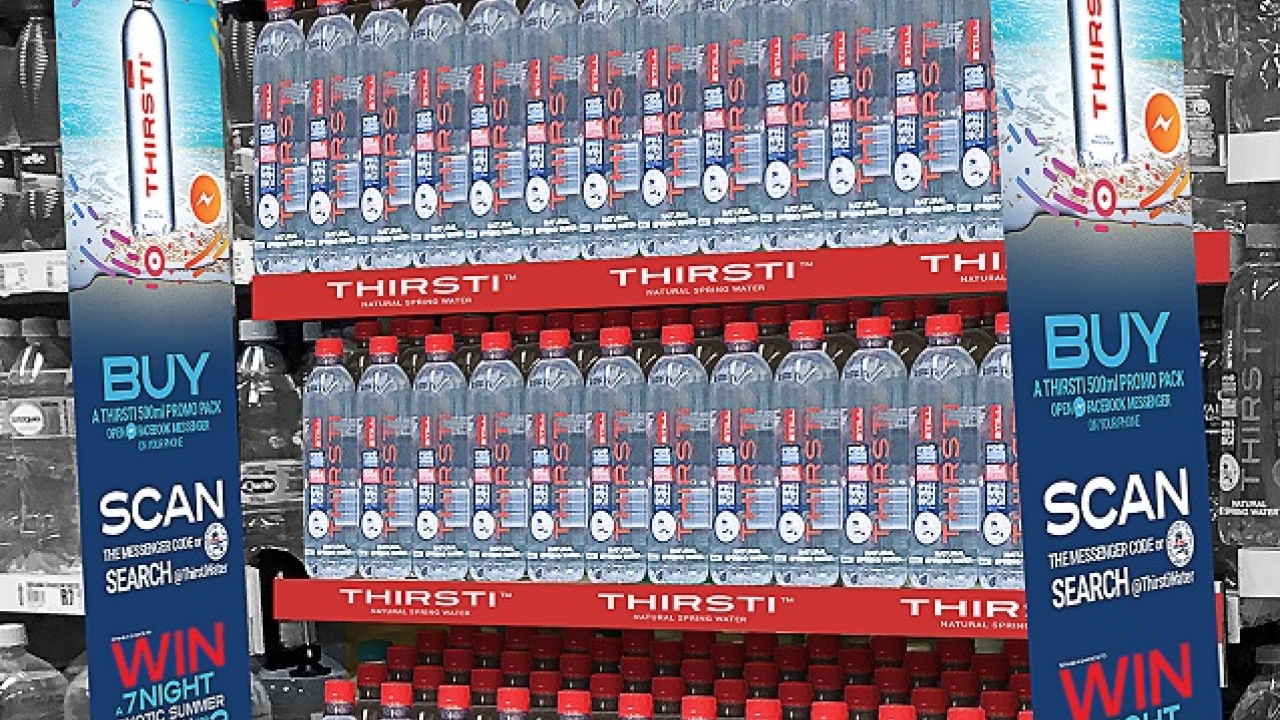Interactive labels enhance consumer engagement

From August to October 2017, Durban-based Uniprint and sister companies in the Hirt & Carter Group created ground-breaking interactive labels – linking printed packaging with a mobile digital device platform – for the 2017/18 ‘Thirsti 4 Summer’ sales campaign.
A scannable label carrying Facebook Messenger codes allowed consumers to connect directly to the Thirsti Facebook Messenger page, via their smartphones, and to interact with a sophisticated ‘chat bot’.
Driven by artificial intelligence software, this ‘chat bot’ offered consumers a personalized, login-free engagement via their Facebook Messenger profiles. The ‘bot’ not only provided advice on hydration and sipping frequency, but also facilitated entry to the ‘Spin and Win’ competition. As Uniprint MD Grant Hubbard, excitedly remarks, the days have gone when a printed label merely included a graphic design, a logo and a list of ingredients.
‘Labels can now offer an entire personalized digital experience, engaging consumers in ways not dreamed of a few years ago,’ he enthuses. ‘This project, the first of its kind in South Africa, personalized and leveraged consumer experience to increase brand approval and drive sales. We combined conventional print with a bespoke social media platform, allowing the brand owner to shake hands with consumers via these scannable technologies. Additionally, we didn’t need to use variable data printing to achieve this level of personalization.’
Design and software wizardry
The existing Thirsti branding featured a clean, contemporary, one-color label design, reflecting the company’s youth and dynamism. The digital campaign was required to maintain this brand integrity, while carrying promotional text, a scannable code and a unique number for competition entry.
The design team set to work to maximize label space. Blue and white promotional graphics were inlaid into the existing design along with space for the Facebook Messenger code. Placing a scannable code on a curved bottle surface that could be read by any smartphone was a huge challenge, and involved extensive trials.
The digital team was also involved in considerable software development to ensure the ‘chat bot’ could successfully engage with consumers, and to create the ‘Spin and Win’ competition platform.
Developing a system that could successfully process the unique competition number on each bottle via the Facebook Messenger page was key for the promotion’s success. In addition to ensuring that consumers had to purchase a bottle of water to enter the competition, the system also had to serve as a database for collecting valuable marketing information and for tracking and delivering prizes. It was vital to ensure that the prizes – ranging from cellular data to shopping vouchers – were purchased, recorded and delivered correctly.
According to the project partners, the campaign attracted over 12,000 competition entries over the three-month period, an unusually high number for such a promotion.
Printing wizardry
To flexo-print the label required significant technical know-how. Firstly, an ultra-clear polypropylene substrate was chosen to provide a ‘no-label’ look – critical to the product’s established brand identity.
Secondly, the label design, which anticipated a CMYK print, was reproduced in three spot colors to ensure tight registration and perfect ‘scannability’.
‘It was also essential to ensure the flexo plates were sufficiently durable to maintain accuracy over the long print runs required by the customer. The codes and label design were printed in-line, in blue on a white background – as opposed to directly on the substrate. Ink choice and compatibility were critical,’ Grant Hubbard remarks. ‘The white background had to be sufficiently opaque to prevent the code’s scannability being compromised by light reflections through the bottle. The fine type on the clear label is testament to the quality of the flexo printing.’
Finally, each unique competition number was inkjet-printed during the final rewinding process, a method chosen to ensure that no numbers were lost in set-up stages and roll changes throughout the various stages of the printing process.
To drive awareness of the new engagement technologies and competition possibilities, as well as to ensure the success of the 2017/18 ‘Thirsti 4 Summer’ promotion, Uniprint’s partners reproduced the concept design on in-store point-of-sale stands, wobblers, banners and shelf talkers. Ultimately, the campaign drove a massive surge in sales for Thirsti, resulting in Uniprint’s having to produce a second run of labels.
Being tech savvy is key
By designing, developing and implementing this project in just three months, Uniprint and sister companies in the Hirt & Carter Group have paved the way for interactive labels to change the face of FMCG product marketing. In Grant’s view, success is no longer about who has the largest factory or the widest range of equipment. ‘The market is challenging flexible packaging and label printers to combine technologies in innovative ways,’ he maintains. ‘We have to be able to offer our customers new ways of differentiating themselves from competitors. In the past, digital media and print technologies were often seen as rivals – now they’re working in partnership as complementary forces.
‘This Thirsti project is an excellent example of Uniprint’s taking full advantage of its partners’ capabilities to harness complementary technologies and create specialized solutions for customers.’
Furthermore, he adds, Uniprint is continually upskilling its workforce and technology so that what was considered impossible just yesterday is a reality today. ‘It’s a very exciting time for everyone,’ he concludes.
Stay up to date
Subscribe to the free Label News newsletter and receive the latest content every week. We'll never share your email address.


